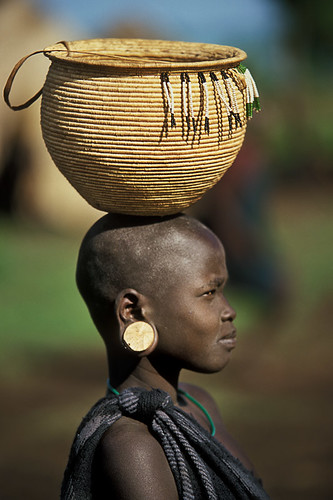Colorful Basket

Colorful Basket, originally uploaded by BoazImages.
The photographer: “A young Mursi Girl with a beautiful basket on her head.”
Lower Omo valley
Ethiopia

Colorful Basket, originally uploaded by BoazImages.
The photographer: “A young Mursi Girl with a beautiful basket on her head.”
Lower Omo valley
Ethiopia
The Photographer: “Another one of those old people I met in Madurai. This one was near another temple outside the city.”
A model posed in the garden of Kinkakuji Shrine (Golden Pavilion). After I took this photo, someone told me she wasn’t a maiko (a young geisha-in-training), but just a young woman posing in traditional formal Japanese wear for a commercial.
Kyoto, Japan, 2004
The author: “Although Sapa means “sand village” in Chinese, Sapa is located within Vietnam and is home to a wealth of colorful, diverse hill tribes, who have steadfastly resisted integration into Vietnamese society and modern life. In fact, the hill tribes, including the Hmong, the Dao, and the Dai, comprise the majority of inhabitants in the area, outnumbering the Vietnamese who prefer the low lands. Sapa’s central market is a main gathering place for hill tribes from the surrounding villages. They congregate there not only to sell handicrafts, jewelry, orchids, mushrooms, and honey, but to also cultivate relations with other groups, play games, and perhaps find a sweetheart.”
The photographer writes on Flickr:
“This is what she wears if shes gonna marry
The Himba of Namibia
The Himba are semi-nomadic pastoralists who inhabit the Kunene Region in northwestern Namibia. Unlike many indigenous groups in Africa, the Himba have managed to maintain much of their traditional lifestyle, perhaps owing to the fact that the land they occupy is so harsh and unyielding that that it has been rarely coveted by the colonialists and commercial farmers that have affected so many other regions of the continent.
The Himba (together with the Herero) moved into present-day Namibia and Botswana as part of a larger migration of Bantu-speaking peoples from east Africa several hundred years ago. About 150 years ago, the group began to split and a large group that we know today as the Herero moved southward, while the ancestors of the present-day Himba remained.
Today, the Himba live as they have for centuries and manage to eke out an existence by following their herds of goats and cattle to new grazing areas and waterholes as existing areas become depleted. They live in small villages or family groups throughout the Kunene Region (the area known as Kaokoland while Namibia was under South African control prior to independence in 1990). The village had been in place for about three years because those years had brought higher than usual amounts of rain and allowed the nearby land to support growing herds of livestock without moving. During 1980’s, however, this same area experienced a severe drought and many livestock were lost and people went hungry. The fortunes of the Himba are still very much tied to the earth and its weather.
Himba women have a particularly distinctive appearance. Each morning, they cover themselves with a mixture of butter fat, red ochre and local herbs that both gives their body the smooth, reddish appearance the Himba find attractive, plus offers some protection against the desert sun. Married women wear a small headpiece made of soft skin on top of their braided and ochred hair. In addition, they often wear a heavy ornament around their necks that includes a conch shell that hangs between their breasts in the front and a metal-studded leather plate that hangs down the center of their back. They also wear heavy metal rings around their ankles as well as other jewelry made of copper, ostrich shells or woven reeds.
The men of the village were less distinctive in their dress and some had taken to wearing western-style trousers and T-shirts. Some men leave the village to find work in other areas of the country and thus become more exposed to outside influences.”
“Lady’s on the way home, in Morocco”
Ethiopian Orthodox priest.
Nikon FM2 / 85mm Nikon lens
0.120 || Powered by WordPress